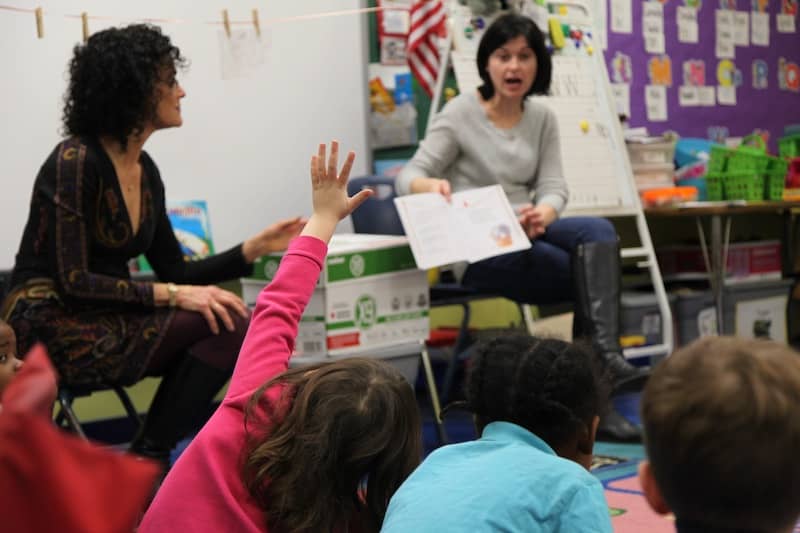Blog
Maryland Wolf Trap Residency with Katherine Lyons
Unique and innovative arts-based strategies are captivating young audiences in Maryland classrooms. At Margaret Brent Elementary/Middle School in Baltimore City, the very youngest students are excited to connect to literature with actress and master teaching artist Katherine Lyons through movement and theater as part of a Maryland Wolf Trap residency.
Katherine creates what she describes as “hands-on, multi-sensory story experiences” by having children actively participate in the telling of the story. Physical motions are assigned to important objects and costumes help illustrate characters. To prepare for Katherine’s arrival on this day, Pre-K teacher Mrs. Lee asked her students to draw what they think will happen in the story. They hung one prediction on a clothesline.

Now, at the front of the room, between Katherine and Mrs. Lee sits a ‘story box’ filled with clues describing the characters in the story. One by one, a student pulls from the box a tool or an article of clothing, then the class takes turns guessing who the clues belong to.
As each character is identified, one student hangs a picture representing the character on the clothesline and another student becomes the character. The students use each of their senses to connect to the story, made ever more lively through the introduction of gestures, chants, and props. “Costumes help bring the story to life,” Mrs. Lee said. “The class is more interested and invested in story time when they get to use props and act it out.”
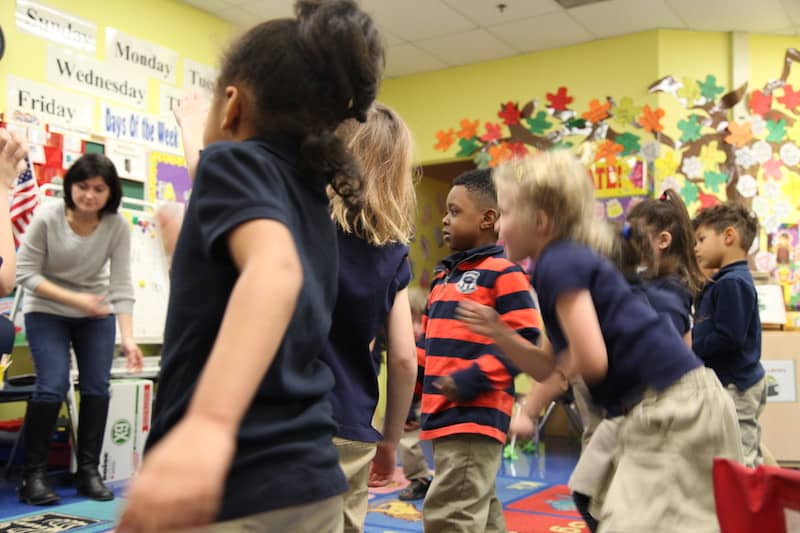
Once story time is completed, Katherine and Mrs. Lee begin planning lessons that they will co-teach. Every Wolf Trap program includes embedded professional development to build teachers’ skills and confidence in arts integration techniques. Teaching artists work with classroom teachers to learn effective ways to engage students in participatory activities that involve all the senses and encourage critical thinking, creativity, communication, and collaboration. This ensures that the arts remain a strong part of the classroom teachers’ lessons long after the residency ends.

Mrs. Lee plans to continue to use these new strategies during an instruction block that includes literacy, social studies and science, but she’s excited to try them out in other areas of the curriculum as well. “I may use the story box with some counting stories and to help illustrate word problems in math!”
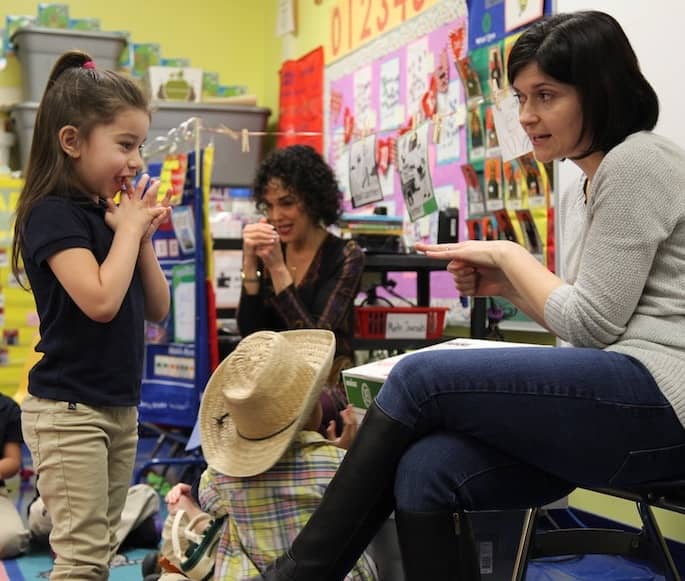
Eighty-five percent of brain development occurs during the first five years of a child’s life. Participation in the arts encourages positive growth in a child’s emotional, physical, intellectual, creative, and social development. As the Maryland affiliate of the Wolf Trap Institute for Early Learning Through the Arts, Young Audiences expands access to the arts for Maryland’s youngest students during the critical early learning years. Bring a Maryland Wolf Trap 16-Session Residency into your school.
Bloomberg Arts Internship: Designed to Challenge and Inspire
 Young Audiences of Maryland and the Greater Baltimore Cultural Alliance are searching for 25 rising Baltimore City public high school seniors for a six-week paid summer internship!
Young Audiences of Maryland and the Greater Baltimore Cultural Alliance are searching for 25 rising Baltimore City public high school seniors for a six-week paid summer internship!
In 2012, Bloomberg Philanthropies created the Bloomberg Arts Internship program in New York City as a pipeline for public school students to college and careers. It is a rigorous program with three major elements: a six-week placement and project working day-to-day in an arts organization; visits to arts/cultural organizations; and professional development. This program’s success led the foundation to expand its reach, first to students in Philadelphia, and in 2017, to Baltimore City. Young Audiences and GBCA are thrilled to be able to offer this opportunity to Baltimore City School students as well as Baltimore’s arts and cultural institutions.
This is so much more than a summer job, it is a chance for young scholars to be challenged and inspired while getting meaningful, real-world experience. This phenomenal opportunity is made possible through the Bloomberg Arts Internship program which places qualified students at arts and cultural institutions across Baltimore City. This summer, 25 students will participate in a rich, immersive, and dynamic learning environment in which they will build career skills and plan for their futures. Baltimore’s renowned and reputable arts and cultural organizations will guide interns through both creative and administrative projects, offering a unique perspective of day-to-day operations within the art world.
STUDENTS
Interns are paid $9.25 per hour for 35 hours per week for the six-week internship, and an additional 20 hours during the orientation week—a total of 230 hours from June 20 – August 4, 2017. To apply, students must be enrolled in a Baltimore City public high school and:
- Successfully complete junior year in 2016-17
- Be 16 years of age or above by June 15, 2017
- Have a passion for the arts
- Commit to attend the 35-hour/week internship plus 20 hours of orientation (June 20-23)
- Commit to working full-time for 6 weeks from June 26-August 4
- Be able to work legally in the U.S.
Applications are due March 31, 2017
Submit an Application | Learn More
ARTS & CULTURAL ORGANIZATIONS
Arts and Cultural organizations play a critical role in The Bloomberg Arts Internship. We are looking for 12-15 partners with the capacity to provide a rich, quality experience for the interns and meet the necessary Bloomberg guidelines. Worksite partners will be paid $750 per intern to help offset the costs of staff time in supervising and guiding the intern(s). Although only 12 to 15 organizations will be selected as worksite partners, there will be other ways to collaborate with us on BAI, such as hosting visits as part of the cultural field trip days or participating as a presenter/panel member as part of the professional development curriculum.
The YA/GBCA team comprises members with expertise in arts leadership and management, curriculum development, and arts education. Partners can expect consistent support from the YA/GBCA staff throughout the program.
Applications are due April 14, 2017
Apply to Become a Worksite Partner | Learn More
For more information
contact Chaz Walters, Bloomberg Program Coordinator
[email protected] or call (855) 245-2787
“We are not going for noise, we are going for the core.”
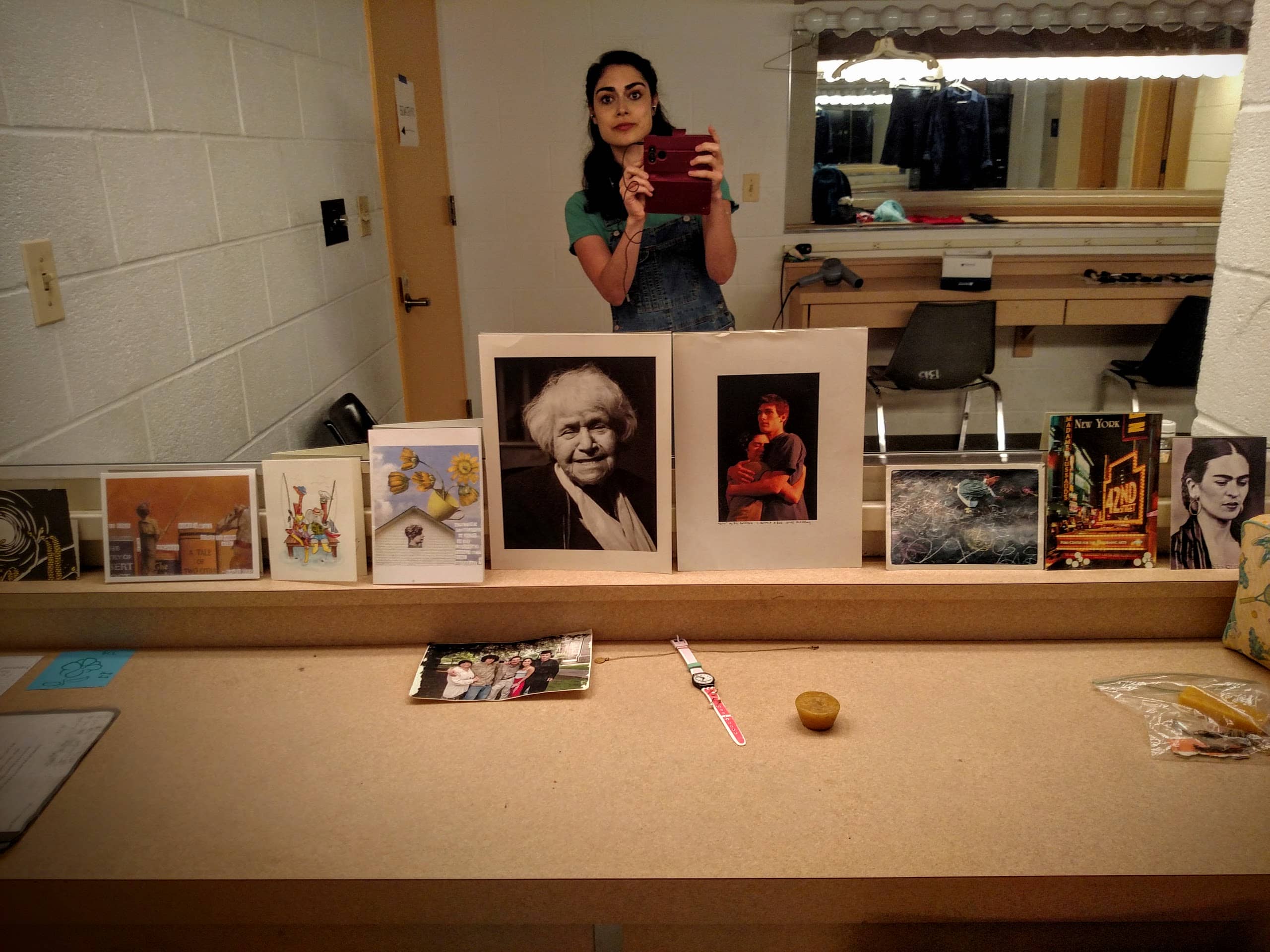
Written by Tea Carnell, an active Young Audiences board member, Chair of 50,000 Kids Committee, and member of the Literature to Life Fundraising Committee.
Last fall, I was lucky enough to see Literature to Life’s staged presentation of Sue Monk Kidd’s The Secret Life of Bees in Washington, DC at a fundraiser hosted by Laura Handman, daughter of Literature to Life’s creator, Wynn Handman. Wynn Handman is also one of the founders of The American Place Theatre in New York City. That night, we were raising funds to bring this program to Prince George’s County Public Schools where it was performed last week.
I was moved by The Secret Life of Bees because, among other things, it touches on themes relevant not only to the students, but to everyone: racism and prejudice, the power of women, the vulnerability of women, what is real versus what is presented to us, and guilt and forgiveness. These issues are weighty and the performance compels the audience to confront them, showing that performance can exceed entertainment and that life’s biggest questions and broadest experiences can be captured and expressed. With the leadership of the teaching artist, Literature to Life creates an opportunity for students to consider and reflect. Wynn Handman once said, “There is so much noise in the entertainment world today, but where is the mind? We are not going for noise, we are going for the core. We do things that stay with youth, that get to them in a deep way…. That’s how we connect with youth. There is nowhere to hide from the story once the actor begins.” This opportunity is important for all students. And, it is especially critical for those students who don’t have access to the arts.
The performance of The Secret Life of Bees is accomplished just by one woman, Lily Balsen, playing all of the characters, and using verbatim excerpts from the novel. The actress spins these elements into a seamless production. I was lucky enough to see it again last week, on International Women’s Day. Of course, The Secret Life of Bees is a novel about women, and written by a woman. The date of the showing was a coincidence – a little serendipitous. Young Audiences/Arts for Learning was ‘showing off’ Literature to Life to a Baltimore-based audience interested in, and supportive of, arts in education.
This performance coalesced around the messages I had grown up with and personalized them for me with an immediacy that I had not yet experienced in the suburbs where I was growing up.
As I’ve thought about these wonderful performances, I have been reminded of the impact that a single play had on me as a child. I grew up just outside of Philadelphia in the mid-1970’s. In 1976, my parents took us to see One Acre at a Time at Freedom Theatre. Freedom Theatre is a Philadelphia-based theater company whose mission is “rooted in the African American tradition.” The play was intense, it made me uncomfortable, and the experience left me with lots to think about as a young person. During my childhood, my parents tried to educate me and my brother about the importance of the Civil Rights Movement. I always understood what they were telling me and accepted that racism and discrimination were wrong. I don’t remember the specific plot at this point. I do remember the impact of the emotion and passionate expression in the context of historical issues of race in the United States. This performance coalesced around the messages I had grown up with and personalized them for me with an immediacy that I had not yet experienced in the suburbs where I was growing up. That experience sits with me today and has left me with messages I don’t think could have been communicated in a more compelling way.
Literature to Life brought me back to that experience of being a child, moved profoundly and enduringly by a performance. I feel strongly about the power of theatre in the lives of students. Theatre has many layers for students beyond audience: content, expression, production. Children benefit from them all – as young writers, performers, writers, artists, stage crew.
4,000 young people will experience the staged presentation Secret Life of Bees and, afterward, participate in a “talk back” with Young Audience teaching artist Molly Moores and the phenomenal actress Lily Balsen, who travels from New York for these performances. The schools participating in the tour include:
Annapolis Road Academy
Bowie High School
Dr. Henry A. Wise, Jr. High School
International High School at Langley Park
International High School at Largo
Largo High School
Northwestern High School
Mount Washington School
Southwest Baltimore Charter School
I hope that Literature to Life will find its way to many more Maryland students. To learn more about the program, visit literaturetolife.org.
If you are like me and care about the power of theatre, or more broadly about the power of the arts in our schools, I suggest you get to know more about Young Audiences/Arts for Learning at one of its regular Bright Side events. Bright Side events are not fundraisers, rather they are one-hour, fun, interactive presentations that go more in-depth about our work (including all of our programs beyond theatre with music, visual arts, and dance) and share stories of the people we serve. The next event will be on March 21st at 5:30 pm at Herman, Sessa & Dorsey in Hunt Valley (307 International Circle Suite 280, Hunt Valley, MD 21030). To RSVP for this event, please email Chaz Walters at [email protected].
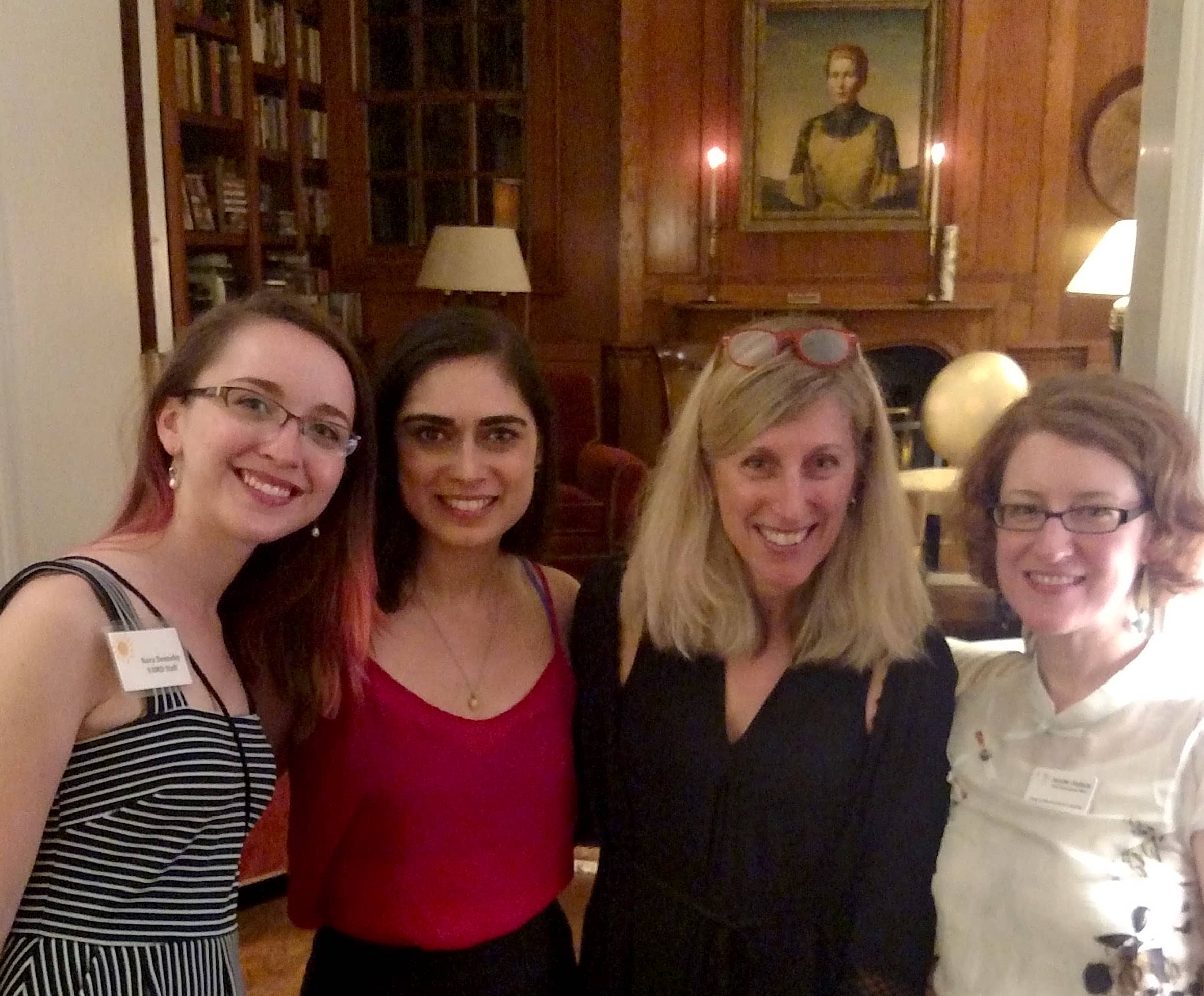
A Sense of Belonging: Ssuuna at Dr. Henry A. Wise, Jr. High School
Young Audiences teaching artist Ssuuna, a dancer, musician, and storyteller from Uganda, brought his incredible stage presence to Dr. Henry A. Wise, Jr. High School recently. There, he taught over 100 high school students African dance and drumming using the same focused energy and passion he delivers on stage. What struck the teachers in attendance, however, was how well Ssuuna guided his students in building a community and how expertly he handled distractions in the classroom, even with pointed interruptions.
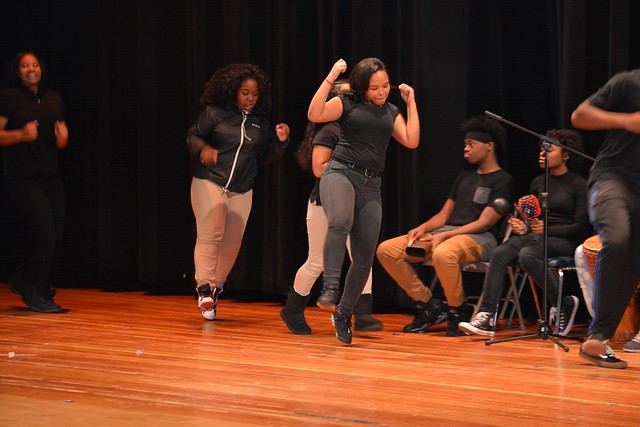
“He never raised his voice with them, but made it clear that their choices would have consequences,” recognized Mrs. Black, a 9th-grade teacher at the school. By encouraging students to examine each of his or her options and the consequences and rewards that go along with them, Ssuuna cultivates classrooms built on cooperation and encouragement. “He put the responsibility on the students to take ownership of their actions and choices, and it was very meaningful for students to have that responsibility.”
Another participating teacher, Mr. Hughes, observed that the residency made students feel more relevant. “Ssuuna met the students where they were and gave them confidence and a sense of belonging, no matter what their interest,” he said. This “relevancy” seemed to be felt not only internally, but collectively. Participants created their own inclusive ritual by uniting and forming a prayer circle before performing at the culminating dance. Mrs. Black recalled how powerful the moment felt to her, “I was really inspired to see all kinds of students coming together to be supportive and work as a team in that way.”
It is so important for students to be understanding, especially at this age, rather than making others feel like they don’t fit in.
The culminating dance introduced one last challenge when a student suffered a panic attack onstage. Ssuuna stepped in to join the student and spoke with her. In the moments that followed, she was able to regain control, breathing and finally relaxing. Teachers could actually see the transition from panic to calm occur within the student. Mrs. Black described the experience as transcendent for the teachers, the students, and the audience. “That moment made the whole experience feel more intimate, supportive, and vulnerable,” Mrs. Black explained. By witnessing first-hand Ssuuna’s kindness and encouragement with the student in distress, the audience was inspired to also be encouraging and supportive. “It is so important for students to be understanding, especially at this age, rather than making others feel like they don’t fit in.”
Honoring Black Women in Science
At the oldest public all-girls high school in the United States, students recently had the opportunity to work with fiber artist Pam Negrin to stitch the likenesses of important, black, female scientists onto one collaborative work of art. Along with partner teacher Jennifer Becker, and with help from both the science and graphic design departments, Pam worked with Western High School students on the large project from conception to realization.
“Many of these women truly were ‘hidden figures’ and one of the scientists, Stephanie Hill, was a Western alumna!”
 Drawing inspiration from the New York Times best-selling book, Women in Science, the group of students and teachers approached the project with reverence. “We lovingly call it our ‘Women in Science Mural’,” Mrs. Becker says of the artwork depicting portraits of women who paved the way for her students. “Many of these women truly were ‘hidden figures’ and one of the scientists, Stephanie Hill, is a Western alumna!”
Drawing inspiration from the New York Times best-selling book, Women in Science, the group of students and teachers approached the project with reverence. “We lovingly call it our ‘Women in Science Mural’,” Mrs. Becker says of the artwork depicting portraits of women who paved the way for her students. “Many of these women truly were ‘hidden figures’ and one of the scientists, Stephanie Hill, is a Western alumna!”
Three different classes participated in this exciting project. “First, Western’s lead science teacher, Ms. Washington, came up with a list of 25 women who have made important contributions in STEM fields,” Mrs. Becker explained. “Graphic design students were tasked to research each of the 25 scientists, then collaborated with another group of students in a fine art class to turn these women into beautiful embroidered portraits.”
 Pam taught the students how to project drawings onto fabric to create their own patterns. They learned various embroidery stitches to create different textures for hair, clothes, skin, and even a stitch for teeth! “Pam Negrin’s residency was the highlight of our year. The students are eager to see their finished artwork on permanent display in the Science department.”
Pam taught the students how to project drawings onto fabric to create their own patterns. They learned various embroidery stitches to create different textures for hair, clothes, skin, and even a stitch for teeth! “Pam Negrin’s residency was the highlight of our year. The students are eager to see their finished artwork on permanent display in the Science department.”

Pam Negrin’s artwork includes embroidery, appliqué, drawing, collage, improvisational quilting, printmaking and sculpture. Her residencies transform classrooms into creative and collaborative handwork studios where students create something beautiful together. Schedule one of Pam’s residencies for your classroom.
Celebrate Black History Month Through the Arts
With Black History Month upon us, we celebrate the contributions, activism, culture, and experience of African Americans. Many of our artists at Young Audiences have designed performances and assemblies to connect students with African American history and develop an in-depth understanding of the unique stories, struggles, and accomplishments of the past and the present. The following are just a few of the many talented artists available to bring a meaningful connection to African American history into your school.
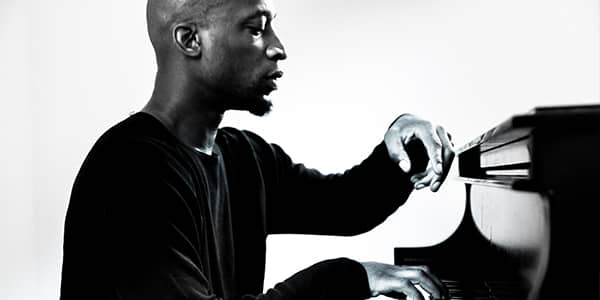
Kevin Gift introduces renown jazz pianists from Thelonius Monk and Art Tatum to Keith Jarrett in his assembly, Jazz Piano Masters. Students learn not only about the important contributions these musicians made to American music, but they also experience how improvisation can make practicing anything more enjoyable and personally satisfying.

Debra Mims has been an actress for over thirty years and was an arts producer at PBS for fourteen years. With additional training in dance, she received a BFA in Theatre Performance from Marygrove College in Detroit, Michigan. She has performed at the Georgetown Theatre Company, the Children’s Theatre in Madison, Wisconsin, and the Detroit-Windsor Dance Company.
In My Grandmother Told Me: A Tribute to African-American Women, Debra uses monologues, poetry, and song to tell tales of days past and of courageous Black women and their struggles to be free, to vote, and to get an education.
Professional spoken word artist and slam poet Femi the DriFish uses his artistry to encourage his listeners to discover their own unique voices and identities in his writings, performances, and teachings. His poetry performance, Write On, Then Say Word! is a spoken word/slam poetry journey through the various reasons to write and perform. Throughout the assembly, Femi shows students that they can draw subject matter for poetry from their identity and history.


Schedule artists and programming to celebrate Black History Month by visiting our website.
Young Audiences Summer Arts Programming Improves Academic Performance
Baltimore students in Young Audiences Summer & Learning Arts Academy Outperform Peers
Baltimore City Public Schools students who participated in a new arts-related summer academic program from Young Audiences avoided summer learning loss and, in many cases, gained ground on their national peers in standardized testing, according to evaluations released Tuesday. The new findings showed potentially groundbreaking progress in tackling summer learning loss, a chronic challenge facing public schools.
The results, confirmed in two separate studies involving nearly 800 students, are significant because summer learning loss – particularly among students at or below poverty level – is among the most difficult challenges facing the Baltimore school district and other high-poverty schools across the country. During summer, students typically fall below where they ended the previous grade, setting them back as they start a new school year. In fact, a 2013 National Summer Learning Association (NSLA) survey of 500 teachers found that 66 percent reported the need to spend three to four weeks re-teaching students course material at the beginning of the year. Another 24% reported the need to spend five to six weeks doing the same.
“City Schools has enjoyed a great partnership with Young Audiences, not only during the school year but also the past two summers,” said Dr. Sonja Brookins Santelises, chief executive officer of Baltimore City Public Schools (City Schools). “During the summer, Young Audiences reinforces key math and reading concepts through the arts and creative activities – and we’re pleased with the results we’ve seen. When students participate in summer learning programs that help them move ahead or reduce learning loss, they start the school year off stronger.”
The Young Audiences Summer Arts & Learning Academy (SALA), run by the Baltimore-based arts-in-education nonprofit Young Audiences of Maryland in partnership with City Schools, was free for students and held at four sites across the city: Gardenville Elementary, Thomas Jefferson Elementary/Middle, William Pinderhughes Elementary, and Fort Worthington Elementary/Middle. Eighty-eight percent of the participating students were from high-poverty Title I schools.
“These results were a pleasant surprise given that we generally expect that students will lose ground over the summer,” commented Dr. Marc L. Stein, Associate Professor at the Johns Hopkins University School of Education, who conducted a separate program evaluation for Young Audiences which looked at participating students’ academic skill and social-emotional development. “The Young Audiences summer program combines many of the best practices of summer learning programs and appears to be a promising model. These findings deserve to be investigated more rigorously to find out how and for whom the program appears to be working.”
“This is not your typical summer school program,” said Stacie Evans, Executive Director of Young Audiences. “We taught literacy and math through the arts every day and instruction was collaboratively taught by teaching artists and teachers specifically trained in arts-integration methods. If you walked into one of our classrooms, you might have seen students using hip hop music to help solve word problems in math, or creating dances to summarize and sequence main events in a story.”
The Baltimore City Public Schools evaluation found:
- For math, statistically significant results showed that students in grades 3-5 who regularly attended (defined as attending at least 75% of the program) the SALA improved 1.8% percentile points in national student rankings on i-Ready standardized testing from the spring of 2016 to the fall of that year. That compares to a decrease of 2.8% percentile points for city schools students who did not attend any summer programming.
- In reading, SALA students in grades 3-5 with regular attendance fell only .8% percentile points while students who did not attend any summer programming fell 2.1 percentile points upon returning to school in the fall.
- Results for all grade 3-5 students regardless of attendance rate showed SALA attendees falling just .3% percentile points in math and .7% in reading. These were significantly smaller losses than students with no summer programming (down 2.8% in math, down 2.1% lost in reading).
- In literacy, only 3% of the students in grades K-2 attending SALA did not meet their benchmark goal (the empirically derived target score that represents adequate reading progess1) on the standardized DIBELS assessment in the fall after returning to school compared to 8.1% of students not attending any summer programming not meeting the benchmark.
Young Audiences external program evaluation found:
- 79% of students who attended at least 75% of the program and who took pre- and post-tests had a positive change from the first to the last week of the program on a curriculum based measure of mathematics.
- Approximately 60% of students who attended at least 75% of the program and who took pre- and post-test writing prompts showed positive change in their structure and content of their writing.
- 71% of students who attended 75% of the program and were administered pre- and post-assessments showed growth in at least one out of three social emotional competency areas over the course of the program. The social emotional competencies studied were relationship skills, self-awareness, and goal directed.
“The arts offer an extraordinary opportunity, particularly during the summer, to reignite the joy of learning and to set young people on the right course to start the school year strong. These impressive results from Young Audiences mirror findings of the landmark Wallace Foundation study showing that elementary school students with high levels of attendance in high-quality, voluntary summer learning programs can experience benefits in math and reading,” commented Matthew Boulay PhD, National Summer Learning Association founder and interim CEO.
Eric Harrell, father of 9 year-old Academy participant, Aria Harrell, said “Before this academy, I could tell that my daughter was struggling in math. By using the arts she was able to learn math in a different way-a way that worked for her. She has so much more confidence in her math class.”

1 “Dibels Next Benchmark Goals and Composite Score, “ Dynamic Measurement Group, Inc. (December 1, 2010). https://dibels.uoregon.edu/docs/DIBELSNextFormerBenchmarkGoals.pdf
Links to complete City Schools and Young Audiences Evaluations:
YAMD evaluation
Young Audiences’ Summer Arts & Learning Academy is funded by Baltimore City Public Schools, The Abell Foundation, The Family League of Baltimore with the support of the Mayor and the City Council of Baltimore, The Alvin and Fanny B. Thalheimer Foundation and individual contributions to Young Audiences. All participants are students at a Title I Baltimore City Public School.
The Inclusive Classroom: Speaking With Our Bodies
Skher Brown teaches world cultural awareness, body coordination and interpersonal skills through the basics of Capoeira Angola, an African-Brazilian martial art form that is a blend between a dance, game, and self-defense. In his new residency, Capoeira Speaks: Dancing for Social Intelligence and Life Success Skills, students develop non-verbal communication skills through body language and kinesthetic movement. This residency is well-suited for inclusive learning settings and those with behavioral, social, emotional, and/or physical disabilities.
“Over 90% of all communication is nonverbal, yet far too little focus is placed on teaching our children how to empathize with others and build relationships. Capoeira Angola is a non-verbal language that uses our bodies to speak instead of our mouths.”
Social intelligence affects how students manage their own behavior, their decision-making process, and how well they are able to navigate social situations. It is, along with academic achievement, one of the greatest predictors of success. Learning to read and respond to body language helps students learn to communicate more effectively, strengthening their social intelligence, thus increasing their chances of success.
“C
apoeira Angola creates a culture of being more aware of one another. It’s communicating all at once with everyone in the room,” Skher explains. “I will say with my movement, ‘I’m about to ask you a question, I need an answer,’ and the student will respond with his or her choice of movement–the ‘answer’. Over 90% of all communication is nonverbal, yet far too little focus is placed on teaching our children how to empathize with others and build relationships. Capoeira Angola is a non-verbal language that uses our bodies to speak instead of our mouths. Once students learn the movements, they come together and begin to have a conversation.”
Capoeira requires students to be very expressive with their entire bodies, including their faces. Participants smile, open their eyes wide, and use animated gestures. These movements help students connect with their own emotions, which translates into being able to recognize and connect to the emotions of others.
“Students take ownership of the new community culture and protect it.”
In Skher’s residency, students take turns observing one another performing the dance movements of Capoeira. “After the dance routine, we form a large circle for participants to look at one another using eye contact. Here, students express what positive observations they noticed about their partners. Then, students share how it felt to give and receive positive reflections. Invariably, though the expressions might start out a little stiff, the mood and classroom environment always turns into a welcoming and connected space. Students take ownership of this new community culture and protect it.”
Skher Brown is one of nine selected roster artists who received training in a variety of inclusion tactics to utilize in the classroom through the Inclusive Allies program in partnership with Disability Rights Maryland. Learn more about our programs for students with special needs and the work we are doing to ensure that all students receive the many benefits of engaging and inclusive arts-integrated classroom experiences.
The Inclusive Classroom: Arts Integration for Every Ability
Arts integration is a valuable tool for reaching multiple learning styles across the curriculum and is linked to enhanced academic outcomes as well as positive social and emotional development for children. While this is true for all students, studies have found that the impact of the arts on language development and core subject learning is particularly beneficial for students with disabilities or those with special learning needs.
As an inclusive organization, Young Audiences’ goal is to bring high-quality, arts-integrated instruction that is accessible, supportive, and welcoming to children of all backgrounds and abilities into the classroom.
Reality is a social definition. Disability is the social process that turns impairment into a negative by creating barriers to access. Difference should be accommodated and celebrated. You can create new ways to create together by taking into account universal access to creativity.
We are diligently laying the foundation for inclusive practice to be incorporated into arts-integrated curriculum, increasing the opportunities for youth of all abilities to participate in artistically-excellent programs. To help us achieve this goal, our staff received specialized inclusion training through the Inclusive Allies program in partnership with Disability Rights Maryland.

Nine selected roster artists also received training, participating in a comprehensive workshop covering a variety of inclusion tactics to utilize in the classroom. YA Roster Artist and FutureMakers founder Matt Barinholtz observed, “Reality is a social definition. Disability is the social process that turns impairment into a negative by creating barriers to access. Difference should be accommodated and celebrated. You can create new ways to create together by taking into account universal access to creativity.”
YA artists approach this “universal access to creativity” by rethinking the norms behind the ways we allow people to communicate, socialize and behave. We create a culture where all students receive the many benefits of engaging and inclusive arts-integrated classroom experiences, adapting lessons with audio/visual cues and different levels of kinesthetic movement, and applying inclusion tactics.
The following Young Audiences Roster Artists have completed the training as of 2016:
- Future Makers/Matt Barinholtz
- Tori Bertocci (Synetic Theater)
- Skher Brown and the Capoeira is Culture Performers
- Anna Menendez
- Jamaal Collier
- Valerie Branch
- Sue Trainor
- Alden Phelps
- Pam Negrin
In the coming months, we will proudly share artists’, teachers’ and coordinators’ stories about their roles in this important work.
“You Are All Now 6th Graders!”
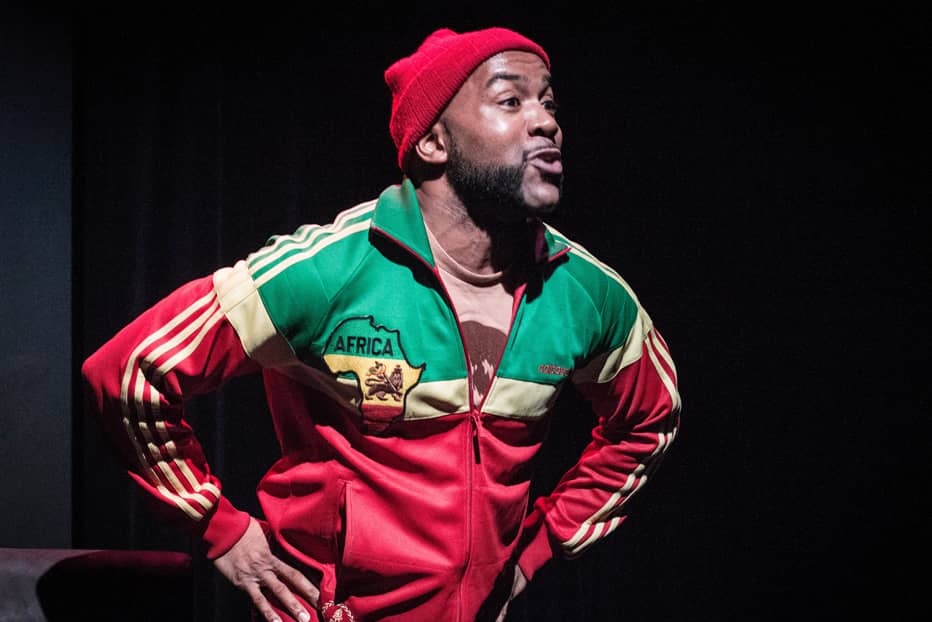
On an early Saturday morning this past fall, Drew Anderson, a hip hop artist, slam poet, screenwriter, producer and veteran school teacher, stood up in front of a sunny classroom filled with teaching artists and commanded:
“You are all now 6th graders!”
That’s how most mock lessons begin at Young Audiences’ Teaching Artist Institute (TAI); a weekend retreat giving Young Audience Teaching Artists and School Teachers the skills they need to maximize the huge potential of arts integration for students in classrooms.
Drew’s bold command at first surprises, but quickly shifts observing teaching artists into the mindset of a student absorbing an unexpected, uncommon classroom experience. A teaching artist himself, Drew asks his “students” to listen to Michael Jackson and break down the beat, eventually re-writing verses with science vocabulary taught by his teacher partner in the classroom, Justin Leonard. The two make an exceptional team, as both have backgrounds in public science education. They smoothly interchange directing the classroom, keeping students engaged – a flow reminiscent of Drew’s own performances on stage.
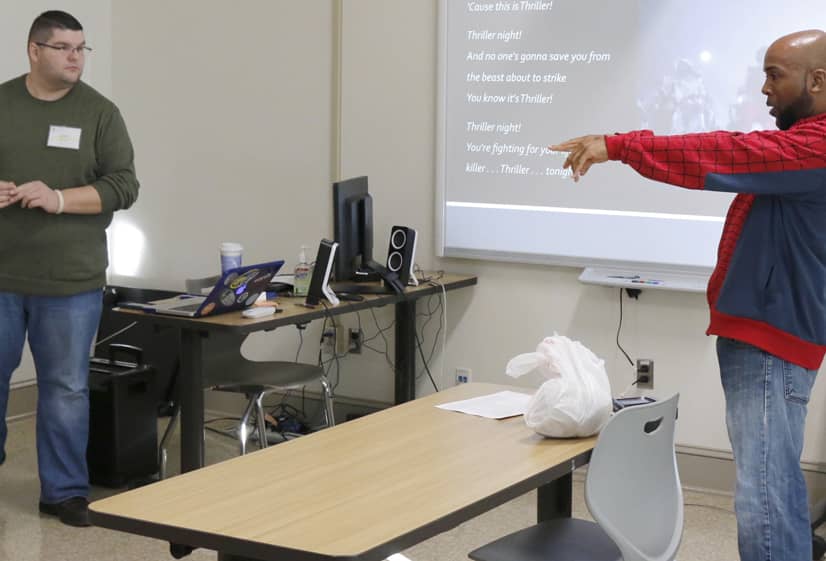
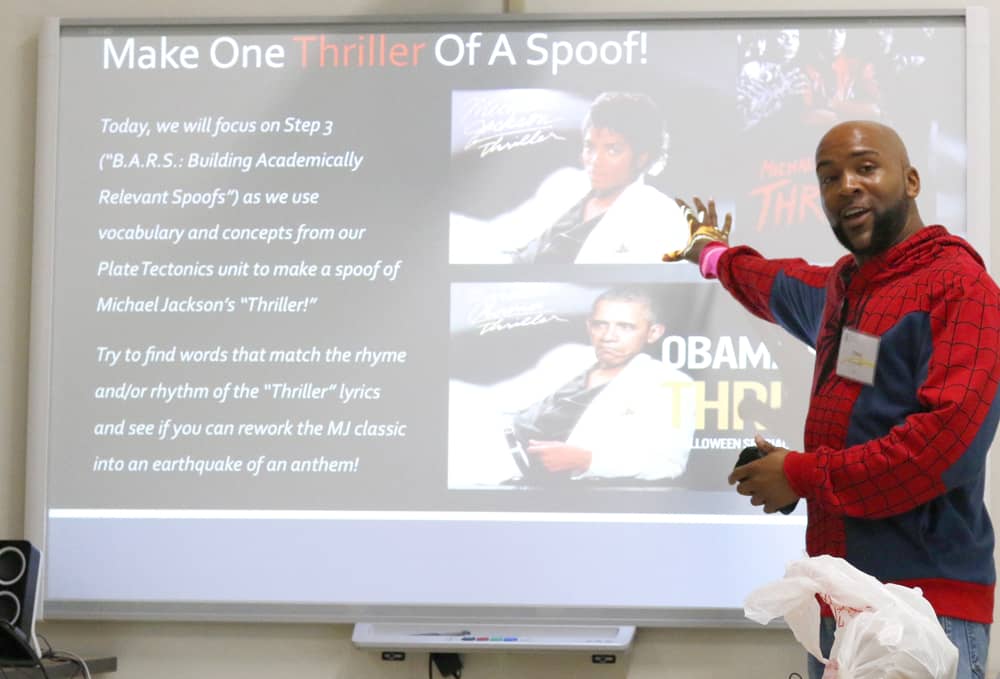
The experience is one of two Common Core compatible arts-integrated performance residencies Drew created at TAI: “C.R.U.N.K. Academy” and “Spoof School” – bridging his longtime passions for performing and teaching.
Here’s an excerpt from Drew for the first lesson of his residency:
The first step is to pick a good song to spoof. It is important to pick a song that is catchy and easily recognizable with simple lyrics. As technology guru, Mr. Leonard will record and project the students’ suggestions for spoof criteria and will play a few songs asking students to put their thumbs up or down to indicate whether the song would be easy or difficult to spoof. Students defend their responses and the creation of replacement lyrics begins!
“TAI
forever altered my understanding of what it is to be a teaching artist.
I learned more than I knew there was to know about arts integration and teaching artistry. I felt utterly enhanced in the realm of mind-shaping magic as if I’d been given a spell book of scholarly sorcery. I learned how to more dynamically apply my art form to educational content, how to break down my creative process for students and teachers, and how to connect my artform to 21st Century Skills, Maryland Art Standards, and the Common Core Curriculum. Every engaging exercise, helpful strategy, and supportive piece of advice from the superb staff and my equally excited peers confirmed that I had found where I belonged.
I am now prepared to convert all the potential energy hidden in classrooms into explosive kinetic energy, using engaging assemblies and super-charged residencies! I’ve been an educator and performing artist for my entire adult life and have observed the changes in both worlds. Gone are the days when students are programmed with rote memorization of stale “facts.” Employers want workers who can think on their feet and on their own. This ever-evolving environment needs young entrepreneurs armed with the creativity to solve problems that have yet to appear. Through its audacity, its abstractions, its “aliveness,” art activates parts of the brain that any teacher or employer should want to turn on. You might find yourself “shocked” at how much electricity comes from the marriage of art and education!”

Interested in learning more about TAI? Click here!
Getting Involved: Volunteering to Support Artists and Arts Integration in the Classroom
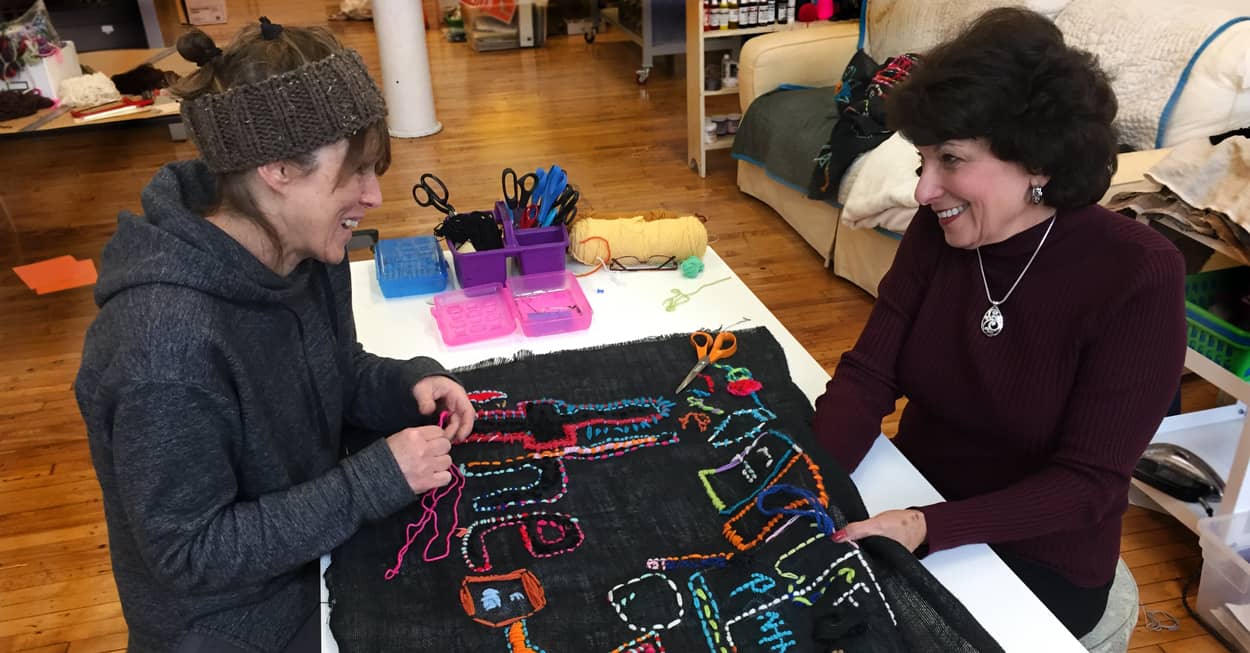
Co-written by Barbara Kesler, an active Young Audiences board member, volunteer, and retired Baltimore County Public Schools teacher and YA Visual Artist Pam Negrin. During Barbara’s 39-year teaching career, she instructed third through sixth-grade students and spent the last 23 years at Franklin Elementary where she taught fifth graders in all subjects.
After attending a Young Audiences informational “Impact Breakfast,” six of my friends and I were intrigued by visual artist Pam Negrin’s embroidery and weaving with students. Pam’s residencies transform classrooms into collaborative handwork studios, with countless ways to connect textile art with core subjects.
We learned that Pam’s hours of preparation, finishing work, and providing one-on-one attention in a classroom of 25-30 students was challenging. With just one teacher and one teaching artist, the need for more hands, heads, and hearts presented a natural opportunity for volunteering with Pam.
 Our volunteering experience happened both in the classrooms and at Pam’s studio. Throughout the experience, new friendships have developed and inspirations shared. Meeting at Pam’s studio, we help while learning; rolling yarn, threading needles, and helping finish collaborative projects. In the classroom, our presence helps individual children feel successful in their completed works—sometimes by giving extra help with a new skill, sometimes by organizing materials, and other times just by listening while they work!
Our volunteering experience happened both in the classrooms and at Pam’s studio. Throughout the experience, new friendships have developed and inspirations shared. Meeting at Pam’s studio, we help while learning; rolling yarn, threading needles, and helping finish collaborative projects. In the classroom, our presence helps individual children feel successful in their completed works—sometimes by giving extra help with a new skill, sometimes by organizing materials, and other times just by listening while they work!
During a Spring residency at Commodore John Rodgers Elementary in Baltimore City, two English Language Arts third-grade classes were exploring character traits of a recently read Judy Blume novel. Expanding this textual element to their own character traits, the children designed self-portraits. The designs started on paper and were then embroidered onto fabric. Pam instructed them to explore color values, textures, and shapes.
Three volunteers accompanied Pam to the school to assist the very enthusiastic children in creating their self-portraits. The results were amazing.
One particularly shy boy proudly presented his self-portrait and said, “I did it!” Another told us how he was teaching his poorly behaved six-year-old cousin to ‘draw with yarn.’ “It calms him down, and we all need that!” he proclaimed. Another student told us that he had taken over the household chore of mending torn clothing for his brothers and sister. “No one else in my house knows how to use a needle like me.”
 Children were working together at sewing tables, chatting amicably about the novel that they were reading in class, their sports activities, and their weekend plans. All were engaged in a very peaceful and friendly manner, helping each other when necessary. No doubt presenting their finished projects to their families on Mother’s Day was a beautiful culmination of this artistic endeavor. And it left three very happy volunteers with a feeling of purpose in assisting these youngsters in a meaningful project that will surely be an unforgettable experience.
Children were working together at sewing tables, chatting amicably about the novel that they were reading in class, their sports activities, and their weekend plans. All were engaged in a very peaceful and friendly manner, helping each other when necessary. No doubt presenting their finished projects to their families on Mother’s Day was a beautiful culmination of this artistic endeavor. And it left three very happy volunteers with a feeling of purpose in assisting these youngsters in a meaningful project that will surely be an unforgettable experience.

You can get involved, too!
At Young Audiences, we constantly see the arts inspire, engage and change lives. We are reminded of this power every day through our work providing more than 7,000 arts learning experiences a year to children in Maryland classrooms. And the benefit extends beyond the children, impacting the providers, observers, supporters and, yes, volunteers. Learn more about how you can get involved with Young Audiences through volunteering.
More peace, more listening
A reflection from Stacie Sanders Evans, Young Audiences’ Executive Director, and Kristina Berdan, Young Audiences’ Arts Integration Specialist.
One thing that people consistently say that they love about being a part of Young Audiences is that we welcome different perspectives and opinions. We, as a team, love that too. We have staff members and board members who may have voted for different Presidential candidates for different reasons, yet we can all come together around this mission. The thing we can unite around, and find comfort and resolve in, is our shared values and vision around what we want for children and for education.
Our teaching artists are doing essential work in schools and are critical at a time when our young people need to feel valued, loved, and part of an authentic classroom community, with the freedom to express their knowledge, values, beliefs, and opinions through all art forms.
Teaching artists bring humanity into classrooms — it is who they are, it is what they do. Our artists use their talents, gifts, spirit, and humanity to lift up and engage the voices of young people. And to provide them with opportunities to explore our world, determine who they are, how they fit into it, and to feel like a part of a community — one that honors and celebrates differences. This is what happens when a teaching artist is in the classroom.
If you were to walk through Young Audiences’ office today, you’d find the hopes and dreams of some of our teachings artists, written out and on display. These hopes and dreams remind us of who we are as a community, what we are doing collectively, and why it is so important that we keep striving to realize our vision that one day, every student in Maryland will have the opportunity to imagine, create, and realize their full potential through the arts.
Today, one artist’s dream, in particular, spoke to us:
“As a teaching artist, I hope to bring more peace
and listening opportunities to students.”
Let’s get behind that! The actions we take on behalf of this mission every day matter. Today more than any other day, we know this to be true.









